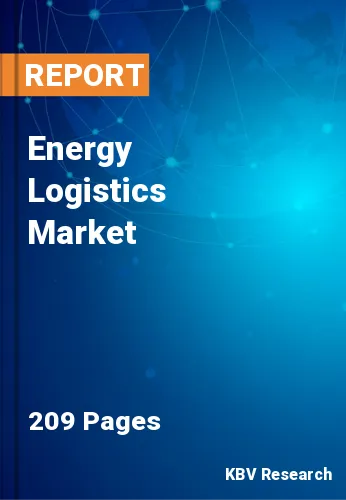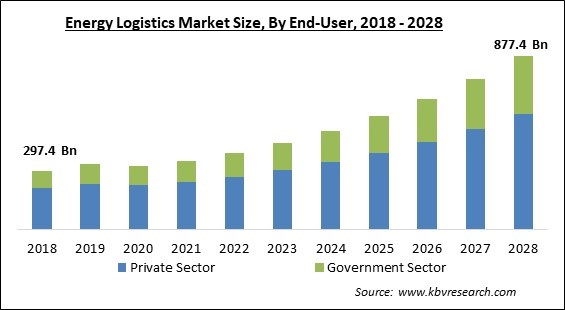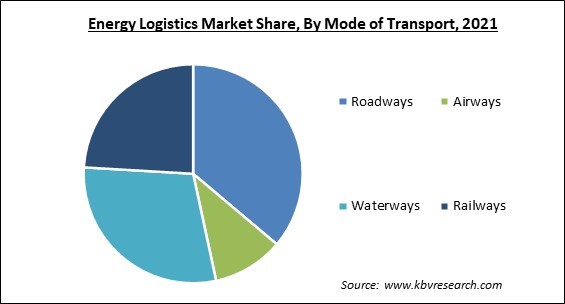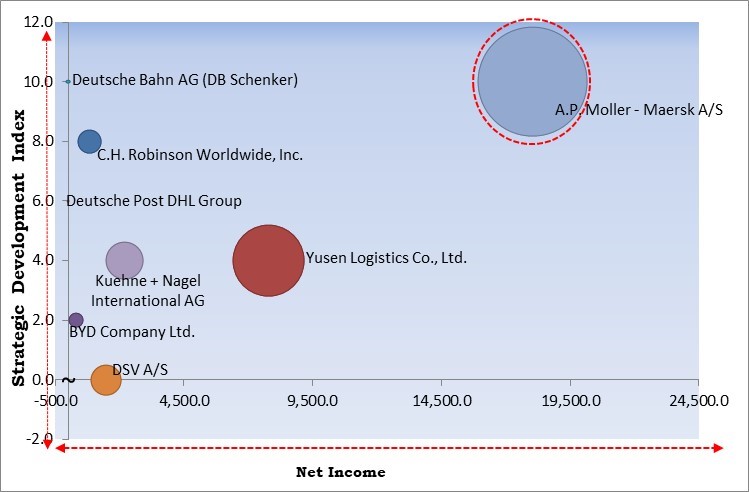
The Global Energy Logistics Market size is expected to reach $877.4 billion by 2028, rising at a market growth of 14.6% CAGR during the forecast period.
The practice of transporting and transferring resources, including machinery, food, liquids, materials, inventories, and people, from one place to the store of the desired location is sometimes referred to as logistics. To fulfill client demands, it is the control of the movement of commodities from one point of origin to the site of consumption. Energy logistics entails the efficient use of personnel, resources, and equipment to transport and distribute energy products within the energy industry. Products like freight shipment, parcel delivery, and document delivery are under the category of services offered in the energy logistics sector. The integration of renewable energy sources is significantly aided by the energy logistics services, which also increase client earnings.

Without the energy sector, no industry would exist. It also accounts for the largest number of projects and installations with high financial worth. As emerging nations continue to increase their manufacturing facilities to meet expanding demand, the number of energy projects worldwide is continuously rising. Energy logistics uses labor, infrastructure, and equipment effectively to drive energy product logistics within the energy sector. Energy companies are attempting things like changing the energy mix and boosting the influence of renewable power on the market. Energy corporations offer high-quality, safe solutions that help energy companies boost production and cut expenses.
Presently, growing Internet of things (IoT) adoption in the industry allows freight businesses to gain direct internet access to the company network. The use of technologically sophisticated systems for logistics improvement and increased expenditure by several energy logistics organizations throughout the globe are additional factors that are anticipated to fuel the market's expansion over the forecast period.
The majority of the COVID-19-affected nations, including the United States, India, Germany, Italy, and the UK, are serviced by China's extensive supply chain network. In addition, all of these nations aside from China engage in trade activities with one another to exchange a variety of goods, both essential and non-essential, such as energy-based goods, automobiles, and their ancillary parts, mobile phones, industrial equipment, and even active pharmaceutical ingredients (APIs). Considering all these factors, the energy logistics market is negatively affected due to the widespread COVID-19 pandemic.
Globalization is primarily driven by the expansion of the economy and the dynamism of the market. A surge in numerous trade-related activities can be attributed to the acceleration of globalization. As a result, it is getting more challenging for retailers or manufacturers to effectively monitor these actions. Energy logistics services are essential for consumers who are price conscious and need a greater selection of high-quality products delivered on time. For major companies, this factor is anticipated to drive the energy logistics market.
The term "last mile logistics" describes the last stage of the delivery from a facility or distribution center to the end customer. A larger emphasis on last-mile transportation solutions is also being seen in the growing pharmaceuticals, chemical, wind, and food and beverage industries. Another possibility that is anticipated to fuel the expansion of the logistics industry in the near future is the ongoing effort made by energy logistics businesses to provide effective last-mile deliveries. The market for energy logistics is anticipated to benefit greatly from the development of last-mile delivery together with logistics automation.
Good supply chains, infrastructure, and trade facilitation are necessary for energy logistics. Without these, businesses must accumulate more working capital and stock reserves, which can have a significant impact on regional and national competitiveness due to high financial expenses. The energy logistics business is further hampered by a lack of infrastructure, which drives up costs and decreases supply chain dependability. These include considerable transportation inefficiencies, shoddy storage facilities, a complicated tax system, a low rate of technology adoption, and inadequate energy logistics professionals. The necessity for huge stocks to cover contingencies as a result of inadequate transportation infrastructure might raise total logistics costs.
Based on application, the energy logistics market is segmented into oil & gas, renewable energy, power generation, and energy mining. In 2021, the oil & gas segment dominated the energy logistics market by generating maximum revenue share. This is due to growing efforts to refine oil & gas from natural reservoirs. Additionally, the logistic service providers have been providing effective energy logistical services, which has fueled the segment's expansion in the market. The explosion in offshore oil & gas exploration, as well as production activities, has increased.

On the basis of end-users, the energy logistics market is fragmented into government sector and private sector. The private sector segment held the largest revenue share in the energy logistics market in 2021. The growth in this segment is the result of the increased contract allocation to private companies for the extraction of raw materials from mines & ores and transportation of them to private locations like power stations or private refineries to be used for energy generation. Thus, the market for energy logistics would grow in this segment.
By mode of transportation, the energy logistics market is divided into railways, airways, roadways, and waterways. The railway's segment procured a significant revenue share in the energy logistics market in 2021. This is because of the expanding e-commerce sector and rising door-to-door delivery. The objective is to maintain affordable multi-modal transportation options, which is a crucial strategy for the logistics industry as it grows regionally.
| Report Attribute | Details |
|---|---|
| Market size value in 2021 | USD 343.1 Billion |
| Market size forecast in 2028 | USD 877.4 Billion |
| Base Year | 2021 |
| Historical Period | 2018 to 2020 |
| Forecast Period | 2022 to 2028 |
| Revenue Growth Rate | CAGR of 14.6% from 2022 to 2028 |
| Number of Pages | 209 |
| Number of Tables | 361 |
| Report coverage | Market Trends, Revenue Estimation and Forecast, Segmentation Analysis, Regional and Country Breakdown, Competitive Landscape, Companies Strategic Developments, Company Profiling |
| Segments covered | Mode of Transport, Application, End-User, Region |
| Country scope | US, Canada, Mexico, Germany, UK, France, Russia, Spain, Italy, China, Japan, India, South Korea, Singapore, Malaysia, Brazil, Argentina, UAE, Saudi Arabia, South Africa, Nigeria |
| Growth Drivers |
|
| Restraints |
|
Region wise, the energy logistics market is analyzed across North America, Europe, Asia Pacific and LAMEA. In 2021, the Asia Pacific region led the energy logistics market with the largest revenue share. This is due to the ease with which outsourced logistics services are adopted and the substantial government support given to the growth of the logistics infrastructure in the region. The market is expanding in the region as a result of the rising import & export business locally as well as internationally which is anticipated to be continued in near future.
Free Valuable Insights: Global Energy Logistics Market size to reach USD 877.4 Billion by 2028

The major strategies followed by the market participants are Acquisitions. Based on the Analysis presented in the Cardinal matrix; A.P. Moller - Maersk A/S is the forerunner in the Energy Logistics Market. Companies such as Yusen Logistics Co., Ltd., Kuehne + Nagel International AG, C.H. Robinson Worldwide, Inc. are some of the key innovators in Energy Logistics Market.
The market research report covers the analysis of key stake holders of the market. Key companies profiled in the report include BYD Company Ltd., Deutsche Bahn AG (DB Schenker), C.H. Robinson Worldwide, Inc., Yusen Logistics Co., Ltd. (Nippon Yusen Kabushiki Kaisha), A.P. Moller - Maersk A/S, DSV A/S, Kuehne + Nagel International AG, Deutsche Post DHL Group, and Hellmann Worldwide Logistics SE & Co. KG.
By End-User
By Mode of Transport
By Application
By Geography
The Energy Logistics Market size is projected to reach USD 877.4 billion by 2028.
The rise in last-mile deliveries and the automation of logistics are driving the market in coming years, however, Inefficient infrastructure and more expensive logistics restraints the growth of the market.
BYD Company Ltd., Deutsche Bahn AG (DB Schenker), C.H. Robinson Worldwide, Inc., Yusen Logistics Co., Ltd. (Nippon Yusen Kabushiki Kaisha), A.P. Moller - Maersk A/S, DSV A/S, Kuehne + Nagel International AG, Deutsche Post DHL Group, and Hellmann Worldwide Logistics SE & Co. KG.
The Roadways market acquired the high revenue share in the Global Energy Logistics Market by Mode of Transport in 2021, thereby, achieving a market value of $302.3 billion by 2028.
The Renewable Energy market has shown high growth rate of 16.3% during (2022 - 2028). This is because of the rising demand for green energy with the aim to cut harmful emissions.
The Asia Pacific market dominated the Global Energy Logistics Market by Region in 2021, and would continue to be a dominant market till 2028; thereby, achieving a market value of $317 billion by 2028.
Our team of dedicated experts can provide you with attractive expansion opportunities for your business.
